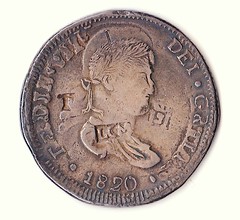
PREV ARTICLE
NEXT ARTICLE
FULL ISSUE
PREV FULL ISSUE
AN INTERESTING MEXICO CITY NECESSITY COIN OF FERDINAND VII
Ralf W. Böpple recently posted a photo of another interesting necessity coin to Facebook - "a counterstamped overstruck countermarked cast modified imaginary bust type necessity coin!" Here it is, along with the description. Thanks!
-Editor
Then the War for Independence started. The city of Chihuahua set up its own coinage operations when it became increasingly difficult to transport the silver mined in the region to the capital, straight through territories plagued by insurgents, rebels and bandits. Little coining equipment was available in the beginning, and no dies, so the coins were cast, using the circulating coins with the imaginary bust from Mexico as models. The design was modified to show the new mint mark CA for Chihuahua. To make sure that the people accepted these crudely looking coins, two marks were applied, a T for the Treasurer and a pomegranate between two crowned pillars as symbol of the comptroller. When in later years the regular dies did reach not only Mexico but also the mint in Chihuahua - now bearing the official portrait bust of Ferdinand VII used all throughout the Spanish empire -, all the makeshift coins the people in the mint of Chihuahua could find were overstruck with the new dies and the official portrait. Some of these coins then circulated in the territories where the Royalists fought with the Insurgents, and again, to prove the validity of the coins, further counterstamp were applied – in our case, "LCM", which is assumed to stand for "La Comandancia Militar" . Thus the pictured item came into existence and now serves as a vivid example of Mexico's turbulent past – as a counterstamped overstruck countermarked cast modified imaginary bust type necessity coin! In 1808, Charles IV, King of Spain, handed over the crown to his son, Ferdinand VII. As one of the most productive mints in the Spanish empire, Mexico City needed to continue striking coins, but now they had to do it under the name of the new ruler. The problem was, however, that they did not have the new official coin designs yet. And worse, with the Spanish motherland occupied by the French, new designs were not going to be sent out in the near future. So the Mexico City mint officials designed and engraved an imaginary bust of how the people in Mexico thought their new king might look like. Then the War for Independence started. The city of Chihuahua set up its own coinage operations when it became increasingly difficult to transport the silver mined in the region to the capital, straight through territories plagued by insurgents, rebels and bandits. Little coining equipment was available in the beginning, and no dies, so the coins were cast, using the circulating coins with the imaginary bust from Mexico as models. The design was modified to show the new mint mark CA for Chihuahua. To make sure that the people accepted these crudely looking coins, two marks were applied, a T for the Treasurer and a pomegranate between two crowned pillars as symbol of the comptroller. When in later years the regular dies did reach not only Mexico but also the mint in Chihuahua - now bearing the official portrait bust of Ferdinand VII used all throughout the Spanish empire -, all the makeshift coins the people in the mint of Chihuahua could find were overstruck with the new dies and the official portrait. Some of these coins then circulated in the territories where the Royalists fought with the Insurgents, and again, to prove the validity of the coins, further counterstamp were applied – in our case, "LCM", which is assumed to stand for "La Comandancia Militar" . Thus the pictured item came into existence and now serves as a vivid example of Mexico's turbulent past – as a counterstamped overstruck countermarked cast modified imaginary bust type necessity coin!
To read the complete Facebook item, see:
Ralf W. Böpple's Photos - A New Year's Greetings to my fellow numismatists!
(www.facebook.com/photo.php?fbid=1507831339163&set=p.1507831339163)
The Numismatic Bibliomania Society is a non-profit organization promoting numismatic literature. See our web site at coinbooks.org. To submit items for publication in The E-Sylum, write to the Editor at this address: whomren@gmail.com To subscribe go to: https://my.binhost.com/lists/listinfo/esylum All Rights Reserved. NBS Home Page Contact the NBS webmaster 
|
 In 1808, Charles IV, King of Spain, handed over the crown to his son, Ferdinand VII. As one of the most productive mints in the Spanish empire, Mexico City needed to continue striking coins, but now they had to do it under the name of the new ruler. The problem was, however, that they did not have the new official coin designs yet. And worse, with the Spanish motherland occupied by the French, new designs were not going to be sent out in the near future.
So the Mexico City mint officials designed and engraved an imaginary bust of how the people in Mexico thought their new king might look like.
In 1808, Charles IV, King of Spain, handed over the crown to his son, Ferdinand VII. As one of the most productive mints in the Spanish empire, Mexico City needed to continue striking coins, but now they had to do it under the name of the new ruler. The problem was, however, that they did not have the new official coin designs yet. And worse, with the Spanish motherland occupied by the French, new designs were not going to be sent out in the near future.
So the Mexico City mint officials designed and engraved an imaginary bust of how the people in Mexico thought their new king might look like.